
The Descriptio Wormatiensis civitatis ('description of the city of Worms'), also known as the Wormser Mauerbauordnung ('wall-building ordinance of Worms'), is an ordinance from about 900 concerning the maintenance of the city wall of Worms, Germany.

The Descriptio Wormatiensis civitatis ('description of the city of Worms'), also known as the Wormser Mauerbauordnung ('wall-building ordinance of Worms'), is an ordinance from about 900 concerning the maintenance of the city wall of Worms, Germany.
The Descriptio, which is written in Latin, is preserved in the Wormser Chronik of Friedrich Zorn . Zorn's work, which dates to 1576, combines material from several sources, including the Annales Wormatienses and the Chronicon Wormatiense . The combined Descriptio, Annales and Chronicon were published under the title Annales Wormatienses by G. H. Pertz. The disentangling of the medieval texts combined in Zorn's was done by Heinrich Boos . [1] The Descriptio has been published three times: by Pertz, [2] by Boos [3] and by Van De Kieft and Niermeyer. [4]
The ordinance appears in the manuscript under the rubric Descriptio Wormatiensis civitatis facta a Theodolacho episcopo Wormatiensi anno 873, qui obiit in Neuweiller anno 914 kal. sept., episcopatus anno quadrageismo primo, "a description of the city of Worms made in the year 873 [ sic ] by Thietlach, bishop of Worms, who died in Neuweiler in the year 914 on 1 September, in the forty-first year of his episcopate". [4]
Issued by Bishop Thietlach (r. 891–914), the Descriptio is more than a description. It is an ordinance assigning Mauerbaupflicht, i.e., the construction and upkeep of specific sections of wall, to both neighbourhoods within Worms and the villages or manors outside it. [1] [5] [6] [7] The ordinance is a unique witness for its place and time. Lynette Olson calls it "a glimpse of transalpine urban life at its nadir, but still organised". [5]
The following places are mentioned in the Descriptio: [4]
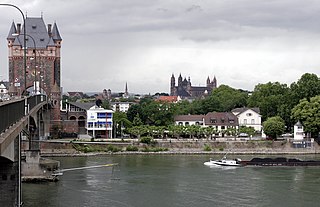
Worms is a city in Rhineland-Palatinate, Germany, situated on the Upper Rhine about 60 km (40 mi) south-southwest of Frankfurt am Main. It had about 82,000 inhabitants as of 2015.
Pope Damasus II was the Bishop of Rome and ruler of the Papal States from 17 July 1048 to his death on 9 August that same year. He was the second of the German pontiffs nominated by Emperor Henry III. A native of Bavaria, he was the third German to become pope and had one of the shortest papal reigns.

Björn Ironside, according to Norse legends, was a Norse Viking chief and Swedish king. According to the 12th- and 13th-century Scandinavian histories, he was the son of notorious Viking king Ragnar Lodbrok and lived in the 9th century, between 855 and 858. Björn Ironside is said to have been the first ruler of the Swedish Munsö dynasty. In the early 18th century, a barrow on the island of Munsö was claimed by antiquarians to be Björn Järnsidas hög or Björn Ironside's barrow.
Fraxinetum or Fraxinet was the site of a Muslim fortress in Provence between about 887 and 972. It is identified with modern La Garde-Freinet, near Saint-Tropez. The fortress was established by Muslims from al-Andalus. From this base, the Muslims raided up the Rhône Valley and into Piedmont. For a time, they controlled the passes through the western Alps. They withstood several attempts to oust them, but were finally defeated by the combined forces of the Provençal and Piedmontese nobility at the battle of Tourtour in 972.

Ubba was a 9th-century Viking and one of the commanders of the Great Heathen Army that invaded Anglo-Saxon England in the 860s. The Great Army appears to have been a coalition of warbands drawn from Scandinavia, Ireland, the Irish Sea region and Continental Europe. There is reason to suspect that a proportion of the Viking forces specifically originated in Frisia, where some Viking commanders are known to have held fiefdoms on behalf of the Franks. Some sources describe Ubba as dux of the Frisians, which could be evidence that he also associated with a Frisian benefice.

Murbach Abbey was a famous Benedictine monastery in Murbach, southern Alsace, in a valley at the foot of the Grand Ballon in the Vosges.
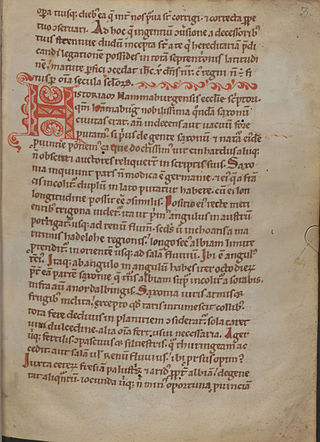
Gesta Hammaburgensis ecclesiae pontificum is a historical treatise written between 1073 and 1076 by Adam of Bremen, who made additions (scholia) to the text until his death . It is one of the most important sources of the medieval history of Northern Europe, and the oldest textual source reporting the discovery of coastal North America.
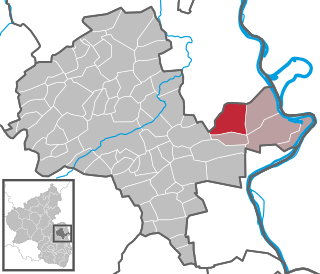
Alsheim is an Ortsgemeinde – a municipality belonging to a Verbandsgemeinde, a kind of collective municipality – in the Alzey-Worms district in Rhineland-Palatinate, Germany.
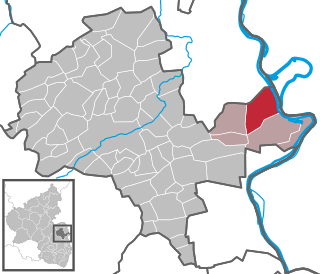
Gimbsheim is an Ortsgemeinde – a municipality belonging to a Verbandsgemeinde, a kind of collective municipality – in the Alzey-Worms district in Rhineland-Palatinate, Germany.

Monzernheim is an Ortsgemeinde – a municipality belonging to a Verbandsgemeinde, a kind of collective municipality – in the Alzey-Worms district in Rhineland-Palatinate, Germany.
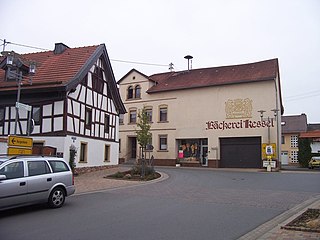
Roxheim is an Ortsgemeinde – a municipality belonging to a Verbandsgemeinde, a kind of collective municipality – in the Bad Kreuznach district in Rhineland-Palatinate, Germany. It belongs to the Verbandsgemeinde of Rüdesheim, whose seat is in the municipality of Rüdesheim an der Nahe. Roxheim is a winegrowing village.
Eich is a Verbandsgemeinde in the district Alzey-Worms, Rhineland-Palatinate, Germany. The seat of the Verbandsgemeinde is in Eich.

Dienheim is an Ortsgemeinde – a municipality belonging to a Verbandsgemeinde, a kind of collective municipality – in the Mainz-Bingen district in Rhineland-Palatinate, Germany.

Ludwigshöhe is an Ortsgemeinde – a municipality belonging to a Verbandsgemeinde, a kind of collective municipality – in the Mainz-Bingen district in Rhineland-Palatinate, Germany. It belongs to the Verbandsgemeinde Rhein-Selz.

The Annales laureshamenses, also called Annals of Lorsch (AL), are a set of Reichsannalen that cover the years from 703 to 803, with a brief prologue. The annals begin where the "Chronica minora" of the Anglo-Saxon historian Bede leaves off—in the fifth year of the Emperor Tiberios III—and may have originally been composed as a continuation of Bede. The annals for the years up to 785 were written at the Abbey of Lorsch, but are dependent on earlier sources. Those for the years from 785 onward form an independent source and provide especially important coverage of the imperial coronation of Charlemagne in 800. The Annales laureshamenses have been translated into English.

The Eisbach, locally known as die Eis, is a 38-kilometre (24 mi) long river and left or western tributary of the Rhine in the northeastern Palatinate and southeastern Rhenish Hesse, in the German state of Rhineland-Palatinate.
The Annales Wormatienses is an anonymous Latin chronicle of the city of Worms for the years 1226–1278. It is a civic history, a relatively new genre in German kingdom at the time. It may be the earliest German example of the type, which originated in Italian kingdom in the 11th century. The goal of such local histories was justify the city's autonomy and self-government. In the case of Worms, independence from the bishop of Worms and the status of a free city within the Holy Roman Empire.
The Chronicon Wormatiense is a fragmentary anonymous Latin chronicle of the city of Worms, Germany. It was probably composed in the last quarter of the 13th century. There is an English translation by David Bachrach.
Rerum italicarum scriptores ab anno æræ christianæ quingentesimo ad millesimumquingentesimum is a collection of texts which are sources for Italian history from the 6th to the 15th century, compiled in the 18th century by Ludovico Antonio Muratori.